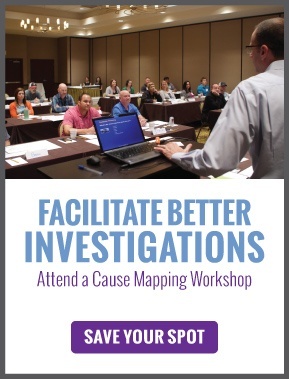*This is the second in a series of 3 blogs.
The first blog captured the details behind a mid-air collision near Moncks Corner, South Carolina on July 7, 2015. This blog captures the details behind a mid-air collision near San Diego, California on August 16, 2015. The third blog details the recommendations put forth by the National Transportation Safety Board (NTSB) in a safety alert released in 2016 related to these collisions. *
On August 16, 2015, a Cessna 172M and North American Rockwell NA265-60SC Sabreliner (Eagle1) collided in mid-air above San Diego, California. All 5 occupants of both planes were killed in the collision. The NTSB, which was also investigating another fatal mid-air collision that had occurred the previous month (see our previous blog on that collision), conducted an investigation. The analysis and conclusions of the NTSB will be presented in a Cause Map, a visual format that develops all the cause-and-effect relationships leading to an incident.
 The first step of the process is to capture the what, when and where of the incident as well as the impact to the goals in an Outline. The collision occurred at 1103 local time at Brown Field Municipal Airport in San Diego, California. At the time of the incident, Eagle1 was inbound for landing and the Cessna was conducting touch-and-go landings. Anything unusual about the situation at the time of the incident is also captured – in this case, there was heavy traffic and a trainee in the air traffic control (ATC) tower.
The first step of the process is to capture the what, when and where of the incident as well as the impact to the goals in an Outline. The collision occurred at 1103 local time at Brown Field Municipal Airport in San Diego, California. At the time of the incident, Eagle1 was inbound for landing and the Cessna was conducting touch-and-go landings. Anything unusual about the situation at the time of the incident is also captured – in this case, there was heavy traffic and a trainee in the air traffic control (ATC) tower.
The collision resulted in 5 fatalities (all crew members aboard both planes). This is an impact to the safety goal. Additional goals impacted include a mid-air collision, which can be considered an impact to the customer safety goal, the NTSB investigation, which impacts both the regulatory and labor/time goal and the destruction of both aircraft, which is an impact to the property goal.
The second step of a Cause Mapping analysis begins with an impacted goal and asking “Why” questions to develop the cause-and-effect relationships. Although a linear analysis consisting of just “Why” questions can make up a basic analysis, a more thorough investigation includes all causes that result in an effect. In this case, the fatalities result from the mid-air collision, which is caused by the two planes being in the same airspace. The two planes were in the same airspace because the Cessna was in the airspace AND Eagle1 entered the airspace. Because both of these causes were required for the effect, they are both linked to the effect and joined with “AND”.
The Cessna was in the airspace because it was practicing touch-and-go landings and it was unaware of Eagle1’s position. The plane received ineffective instructions from ATC as the controller misidentified the aircraft (one of 4 Cessna aircraft simultaneously using the two runways at the airport). The controller was found to have misidentified the aircraft due to “incomplete situational awareness”, having taken over from the controller trainee less than 4 minutes before the crash due to the heavy traffic. In addition, the controller was overwhelmed, being responsible for 9 aircraft, which is above his “personal limit” of 7 aircraft.
The Cessna was not equipped with traffic display or alerts, meaning the only way it would be aware of other air traffic was by visual acquisition. The investigation found that Eagle1 would have been largely obscured from the Cessna pilot’s field of view. The investigation also found that the “see-and-avoid” concept (which “relies on a pilot to look through cockpit windows, identify other aircraft, decide if any aircraft are collision threats, and, if necessary, take the appropriate action to avert a collision”) has inherent limitations that limit its usefulness for collision protection.
The Eagle1 entered the airspace as instructed by the controller in order to land. The controller, who had directed one of the other Cessnas in the airspace to land (mistakenly believing it was the Cessna involved in the collision), assumed but did not verify that the Cessna would turn. The overwhelmed controller did not issue an alert to Eagle1. The “local controller’s (LC) failure to properly identify the aircraft in the pattern and to ensure control instructions provided to the intended Cessna on downwind were being performed before turning Eagle1 into its path for landing” was determined by the NTSB to be the “probable cause” of the accident. The report found that the controller’s “incomplete situational awareness when he took over communications from the LC trainee due to the high workload at the time of the accident” contributed to the controller’s actions.
Eagle1 also was not equipped with traffic display or alerts and, although the NTSB determined that the Cessna should have been within the Eagle1 pilot’s field of view, cockpit voice recordings indicate that the pilot was not aware of the Cessna’s location. As with the Cessna, limitations with the “see-and-avoid” concept likely prevented Eagle1 from visually acquiring the Cessna. The “inherent limitations of the see-and-avoid concept, resulting in the inability of the pilots involved to take evasive action in time to avert the collision” was considered by the NTSB to be “contributing to the accident.”
To view the incident conclusions in Cause Mapping form, please click on the thumbnail above.











